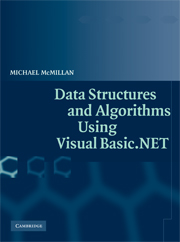Book contents
- Frontmatter
- Contents
- Preface
- Introduction
- Chapter 1 Collections
- Chapter 2 Arrays and ArrayLists
- Chapter 3 Basic Sorting Algorithms
- Chapter 4 Basic Searching Algorithms
- Chapter 5 Stacks and Queues
- Chapter 6 The BitArray Class
- Chapter 7 Strings, the String Class, and the StringBuilder Class
- Chapter 8 Pattern Matching and Text Processing
- Chapter 9 Building Dictionaries: The DictionaryBase Class and the SortedList Class
- Chapter 10 Hashing and the HashTable Class
- Chapter 11 Linked Lists
- Chapter 12 Binary Trees and Binary Search Trees
- Chapter 13 Sets
- Chapter 14 Advanced Sorting Algorithms
- Chapter 15 Advanced Data Structures and Algorithms for Searching
- Chapter 16 Graphs and Graph Algorithms
- Chapter 17 Advanced Algorithms
- References
- Index
Chapter 17 - Advanced Algorithms
Published online by Cambridge University Press: 11 August 2009
- Frontmatter
- Contents
- Preface
- Introduction
- Chapter 1 Collections
- Chapter 2 Arrays and ArrayLists
- Chapter 3 Basic Sorting Algorithms
- Chapter 4 Basic Searching Algorithms
- Chapter 5 Stacks and Queues
- Chapter 6 The BitArray Class
- Chapter 7 Strings, the String Class, and the StringBuilder Class
- Chapter 8 Pattern Matching and Text Processing
- Chapter 9 Building Dictionaries: The DictionaryBase Class and the SortedList Class
- Chapter 10 Hashing and the HashTable Class
- Chapter 11 Linked Lists
- Chapter 12 Binary Trees and Binary Search Trees
- Chapter 13 Sets
- Chapter 14 Advanced Sorting Algorithms
- Chapter 15 Advanced Data Structures and Algorithms for Searching
- Chapter 16 Graphs and Graph Algorithms
- Chapter 17 Advanced Algorithms
- References
- Index
Summary
In this chapter we look at two advanced topics: dynamic programming and greedy algorithms. Dynamic programming is a technique that is often considered to be the reverse of recursion. Whereas a recursive solution starts at the top and breaks the problem down solving all small problems until the complete problem is solved; a dynamic programming solution starts at the bottom, solving small problems and combining them to form an overall solution to the big problem.
A greedy algorithm is an algorithm that looks for “good solutions” as it works toward the complete solution. These good solutions, called local optima, will hopefully lead to the correct final solution, called the global optimum. The term “greedy” comes from the fact that these algorithms take whatever solution looks best at the time. Often, greedy algorithms are used when it is almost impossible to find a complete solution, owing to time and/or space considerations, yet a suboptimal solution is acceptable.
A good source for more information on advanced algorithms and data structures is (Cormen, 2001).
DYNAMIC PROGRAMMING
Recursive solutions to problems are often elegant but inefficient. The VB.NET compiler, along with other language compilers, will not efficiently translate the recursive code to machine code, resulting in an inefficient, though elegant computer program.
Many programming problems that have recursive solutions can be rewritten using the techniques of dynamic programming. A dynamic programming solution builds a table, usually using an array, that holds the results of the different subsolutions.
- Type
- Chapter
- Information
- Data Structures and Algorithms Using Visual Basic.NET , pp. 352 - 378Publisher: Cambridge University PressPrint publication year: 2005
- 1
- Cited by



